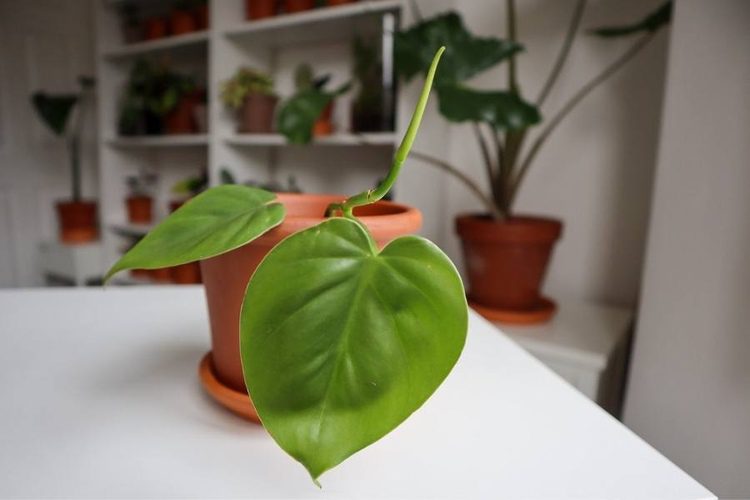How To Care For Red Emerald Philodendron? Detailed Guide

Philodendron Red Emerald is a flowering houseplant rooted in Colombia. People love its shiny, heart-shaped leaves with beautiful red veins that add an exotic vibe and color to every living space. Yet, if you don’t know how to care for a Red Emerald Philodendron, you may never see its flower bloom red.
This guide post will refer you to the ultimate guidelines on taking care of philodendron plants and the best techniques to propagate them.
How To Care For The Red Emerald Philodendron?
There are eight methods to care for the Red Emerald Philodendron, including placing it under indirect sunlight, improper watering, fertilizer, nutrients, and keeping it at an ideal temperature range.
Watering
Overwatering is a common mistake that can cause issues like yellowing leaves, fungus infections, and root rot. If we have to choose, it’s usually better to underwater than overwater your greens. It doesn’t mean you can allow yourself to skip some watering sessions.
It is important to allow the substrate to dry out between watering sessions, but not to the point of completely drying out. You should examine the soil’s softness every day using your fingers.
Don’t forget to water your tropical plants after fertilizing, or the excess fertilizer will hurt them.
Light
Like other philodendron varieties, the Red Emerald Philodendron prefers indirect light, such as partial shade or dappled sunlight. Avoid areas with direct sunlight, like a window facing the south, since this may cause the substrate to dry out rapidly and burn the leaves. Though your greens will grow faster under milder indirect light, the leaves may be smaller.
Temperature
This variety thrives in warm to medium temperatures and may become leggy if exposed to high temperatures. The ideal temperature range is between 55°F and 65°F. It may develop chlorosis (yellow leaves) if exposed to overly high temperatures. We suggest using a humidity meter and thermometer to easily measure the temperatures around your greens.
Humidity
Similar to temperature, humidity is essential to your Philodendron Red Emerald’s success. Generally, the humidity level should be above 60%. Proper humidity will yield bright-colored and full-sized leaves, as you expect. Too low a humidity percentage may cause stunted growth and dry leaves. If the humidity level in your room is under 60%, you can easily increase it by installing a diffuser and humidifier.
Size
A mature Red Emerald Philodendron can reach a height of 6.5 feet and a width of 5 feet. Like Philodendron Golden Dragon, this breed is a pretty fast grower. Since the green is a climbing vine, a trellis or moss pole will help support its dense weight and encourage it to grow upward.
Soil
When choosing soil for the Red Emerald Philodendron, you can consider using either LECA balls or loamy soil. A loamy substrate is a three-component sand, silt, and clay mixture. The silt combines sand and clay properties, improving nutrient retention. Clay is a fantastic element with great moisture retention, whereas sand enables naturally adequate aeration.
We’ve got some tips on amending the clay soil. You’ll need them! If you’re not fond of the feeling of soil sticking to your fingertips, we suggest using LECA balls as an alternative. They may seem tricky to use at first, but you’ll need to rinse the new clay pebble pack, pop the stones in your pot, and dig your plant in.
Fertilizer
Good fertilizer plays a vital role in maintaining Philodendron imperial red. Yet the work is relatively straightforward, with just a tiny compost application. The important thing is to feed the plants during the summer and avoid feeding during the winter or the late autumn months. They need time to relax and rest.
Steer clear of over-fertilizing your greens since excessive fertilizer may burn their roots, creating brown areas on their leaves and hindering their growth.
Potting
As your plant grows, it will need to be repotted annually to accommodate its size. Once it gets established, you will no longer need to repot it frequently. Since the plants feature a vining growth pattern, they’ll require a robust support structure to latch on.
The Red Emerald Philodendron: Propagation Instructions
The two most highly recommended propagation techniques for Philodendron Red Emerald are stem cutting and air layering. On the other hand, dividing is another propagation method for Philodendron Birkin, a plant that has multiple offshoots.
Method 1: Stem Cutting
- Pick a healthy, fresh stem with two to three nodes (more nodes mean a higher success rate).
- Cut the stems just underneath the nodes using sterilized pruning scissors.
- Prepare a decent pot of perlite and sphagnum moss (50%) and keep it moist (50%). The moss must be wet but not soaking.
- Soak the newly cut stems in rooting hormone powder or solution, then plant them in your potting mix. Ensure to cover the nodes where roots will grow.
- The remaining part of the pot will be a perlite mix and spag moss.
- Place the pot in a place with indirect light and warm temperatures. Water and keep the moss moist.
Method 2: Air Layering
- Pick well-established aerial roots growing from a healthy node. Wrap some damp sphagnum moss around that node with a pole and roots.
- Completely wrap the node using a see-through plastic bag or food wrap and seal it.
- Leave the seal’s bottom and top open. Since new roots love diving downward, this practice will help them go down without clustering.
- Wait two to three weeks until new roots start developing. Gently remove the wrap and the moss surrounding the new roots.
- Ensure the roots are healthy by checking if they look white.
- Trim the stem underneath the roots using clean scissors and plant it in a rich potting mixture. Then, take care of it as usual.
Common Diseases In Red Emerald Philodendrons
Yellow leaves
Philodendron’s Red Emerald growing yellow leaves mean it’s suffering root rot. This issue happens due to overwatering. So, always inspect the humidity level before watering. Ensure the substrate is well-drained, and avoid watering if the substrate is soaking.
Leaves become brown at the tips
Your plant’s leaves may turn brown if exposed to direct light for an extended period of time (above three hours per day). This issue also occurs when you submerge the plant. Underwater greens will sometimes grow curly leaves, too.
Common pests
Pests are often no big problem since this variety is highly resilient to pest attacks. Scales, thrips, spider mites, aphids, and mealybugs may attack but weaken and fade away quickly. You can apply neem oil in diluted form or a natural insecticide or pest repellent to remove these pests.
Conclusion
It’s not tricky to learn how to care for your Red Emerald Philodendron and make it a colorful supplement to your living space. The key is that it enjoys dappled light, warmth, low moisture, and high humidity. Ensure to follow every pointer in this care guide, and you’ll win the reward of a luscious, thriving indoor garden.
Related posts:




